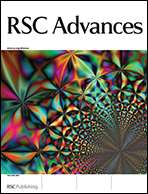A polymer monolith for hydrophilic and dynamically surfactant-modified reversed-phase capillary electrochromatography†
Abstract
A stable poly(META-co-PETA) monolith was fabricated and employed for hydrophilic interaction (HI) and dynamically-modified reversed-phase (RP) electrochromatography. Detailed effects on the column characteristics including the permeability, swelling propensity factor, retention factor, EOF and column efficiency were investigated. Studies on the column stability and heat dissipation were also implemented. The interrupt problem caused by joule heating was eliminated and the satisfactory characteristics in terms of the uniform morphology, good reproducibility and multiple retention modes were gained. Based on the obtained monolith, versatile separation interactions including HI, RP, HI-strong anion exchange (HI-SAX) and RP-SAX were evaluated and utilized for capillary electrochromatography (CEC). Efficient separations of phenols and nucleic acid bases and nucleosides were achieved with HI-CEC. With an easy dynamical modification of sodium dodecylsulfate (SDS), efficient separations of alkyl benzenes, polycyclic aromatic hydrocarbons, estrogens and basic anilines were also achieved with RP or RP-SAX. It presented a facile polymer monolith for hydrophilic and dynamically SDS-modified RP modes in CEC.


 Please wait while we load your content...
Please wait while we load your content...